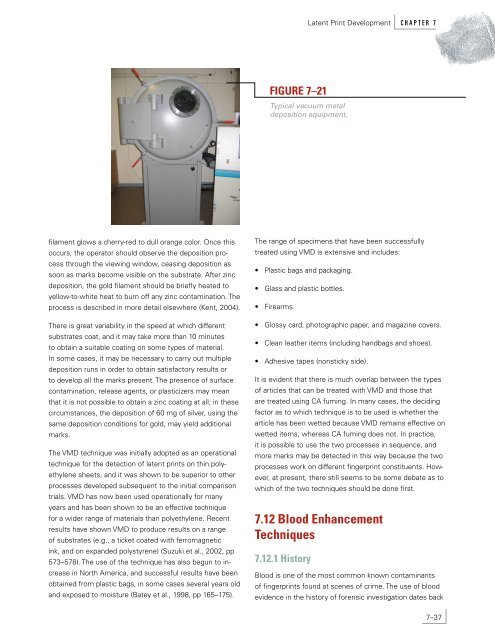Latent Print Development - National Criminal Justice Reference ...
Latent Print Development - National Criminal Justice Reference ...
Latent Print Development - National Criminal Justice Reference ...
Create successful ePaper yourself
Turn your PDF publications into a flip-book with our unique Google optimized e-Paper software.
filament glows a cherry-red to dull orange color. Once this<br />
occurs, the operator should observe the deposition process<br />
through the viewing window, ceasing deposition as<br />
soon as marks become visible on the substrate. After zinc<br />
deposition, the gold filament should be briefly heated to<br />
yellow-to-white heat to burn off any zinc contamination. The<br />
process is described in more detail elsewhere (Kent, 2004).<br />
There is great variability in the speed at which different<br />
substrates coat, and it may take more than 10 minutes<br />
to obtain a suitable coating on some types of material.<br />
In some cases, it may be necessary to carry out multiple<br />
deposition runs in order to obtain satisfactory results or<br />
to develop all the marks present. The presence of surface<br />
contamination, release agents, or plasticizers may mean<br />
that it is not possible to obtain a zinc coating at all; in these<br />
circumstances, the deposition of 60 mg of silver, using the<br />
same deposition conditions for gold, may yield additional<br />
marks.<br />
The VMD technique was initially adopted as an operational<br />
technique for the detection of latent prints on thin polyethylene<br />
sheets, and it was shown to be superior to other<br />
processes developed subsequent to the initial comparison<br />
trials. VMD has now been used operationally for many<br />
years and has been shown to be an effective technique<br />
for a wider range of materials than polyethylene. Recent<br />
results have shown VMD to produce results on a range<br />
of substrates (e.g., a ticket coated with ferromagnetic<br />
ink, and on expanded polystyrene) (Suzuki et al., 2002, pp<br />
573–578). The use of the technique has also begun to increase<br />
in North America, and successful results have been<br />
obtained from plastic bags, in some cases several years old<br />
and exposed to moisture (Batey et al., 1998, pp 165–175).<br />
FIGURE 7–21<br />
Typical vacuum metal<br />
deposition equipment.<br />
The range of specimens that have been successfully<br />
treated using VMD is extensive and includes:<br />
• Plastic bags and packaging.<br />
• Glass and plastic bottles.<br />
• Firearms.<br />
• Glossy card, photographic paper, and magazine covers.<br />
• Clean leather items (including handbags and shoes).<br />
• Adhesive tapes (nonsticky side).<br />
It is evident that there is much overlap between the types<br />
of articles that can be treated with VMD and those that<br />
are treated using CA fuming. In many cases, the deciding<br />
factor as to which technique is to be used is whether the<br />
article has been wetted because VMD remains effective on<br />
wetted items, whereas CA fuming does not. In practice,<br />
it is possible to use the two processes in sequence, and<br />
more marks may be detected in this way because the two<br />
processes work on different fingerprint constituents. However,<br />
at present, there still seems to be some debate as to<br />
which of the two techniques should be done first.<br />
7.12 Blood Enhancement<br />
Techniques<br />
7.12.1 History<br />
<strong>Latent</strong> <strong>Print</strong> <strong>Development</strong> C H A P T E R 7<br />
Blood is one of the most common known contaminants<br />
of fingerprints found at scenes of crime. The use of blood<br />
evidence in the history of forensic investigation dates back<br />
7–37

















